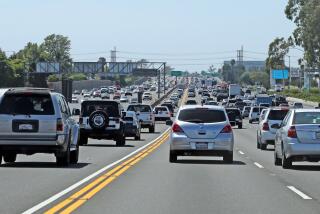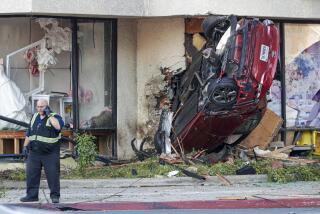Safety Device Ordered for Planes Flying Out of Lindbergh Field
- Share via
Concerned about increasingly crowded skies around major airports, federal transportation authorities Thursday ordered a four-year speedup in regulations that would require additional safety equipment on planes operating out of 13 airports, including San Diego’s Lindbergh Field.
Aviation officials here hailed the announcement, but questioned whether the new requirements would increase safety.
Transportation Department Secretary Elizabeth Dole ordered all aircraft operating out of 14 air terminals in large cities to be equipped with altitude-reporting devices by Dec. 1--speeding up by four years the requirements, which had been scheduled to go into effect by 1992. “In these high-density areas, this new rule will give controllers a continuous readout of aircraft altitude, a more complete view of traffic and improved control,” Dole said.
Buzz Gibbs, owner-operator of Gibbs Flying Service at Lindbergh and Montgomery fields, said that most small aircraft now operating out of Lindbergh and all commercial aircraft already have the altitude digitizers to which Dole was referring.
“Of course the equipment is important and adds to flight safety, but it’s not infallible,” Gibbs, a veteran pilot, said.
The small plane that collided in flight with a PSA jet on approach to Lindbergh in 1978, resulting in 144 deaths, was equipped with altitude-recording gear, Gibbs pointed out.
Dole’s announcement was interpreted by Federal Aviation Administration authorities as a response to the midair crash of a light plane and an Aeromexico jetliner over Cerritos last August in which 67 passengers and crew members on the two craft died and another 15 residents were killed in the resulting firestorm on the ground.
In addition to San Diego, the requirement will apply to areas around airports in Cleveland; Denver; Detroit; Honolulu; Kansas City, Mo.; Houston; Las Vegas; Minneapolis; New Orleans; Philadelphia; Pittsburgh; Seattle, and St. Louis. Altitude-reporting equipment is already required for aircraft operating out of major airports in Atlanta, Boston, Chicago, Dallas, Miami, New York City, San Francisco, Washington and Los Angeles.
Jim Dea, manager of air traffic control operations at Lindbergh, estimated that more than 90% of aircraft using the San Diego airport are equipped with the altitude digitizers, allowing controllers to determine a craft’s “fixed position in two dimensions” relative to other air traffic in the area.
Both Gibbs and Dea estimated that the altitude-reporting equipment would cost about $1,000 to install. Gibbs called the expense “the admission price for operating in a busy area like San Diego, and well worth the cost.”
The new FAA regulation also requires that all new radio equipment installed in aircraft after Jan. 1, 1992, be compatible with a new-technology radar beacon system that will be installed at major airports in the future.
More to Read
Sign up for Essential California
The most important California stories and recommendations in your inbox every morning.
You may occasionally receive promotional content from the Los Angeles Times.










